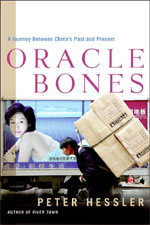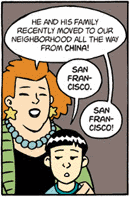One of Taiwan’s government ministries changed its name recently — but just its English name. The Overseas Chinese Affairs Commission has become the Overseas Compatriot Affairs Commission. In Mandarin, however, it remains the Qiáowù Wěiyuánhuì (僑務委員會).
This isn’t the first time under the Chen administration that a government body’s English name has been changed while its Mandarin one was left alone. Here are a few more examples.
| Mandarin Name | English Name | ||
|---|---|---|---|
| Pinyin | Hanzi | old | new |
| Yuánzhùmín Wěiyuánhuì | 原住民委員會 | Council of Aboriginal Affairs | Council of Indigenous Peoples |
| Guóyǔhuì | 國語會 | Mandarin Promotion Council | National Languages Committee |
| Zhōnghuá Mínguó Duìwài Màoyì Fāzhǎn Xiéhuì | 中華民國對外貿易發展協會 | China External Trade Development Council (CETRA) | Taiwan External Trade Development Council (TAITRA) |
Especially ingenious is the change from “Mandarin Promotion Council” (Guóyǔhuì) to the “National Languages Committee.” The root of Guóyǔ, which is the term by which Mandarin is generally referred to in Taiwan (as opposed to putonghua in China), is literally “national language.” But since Mandarin does not have distinct forms for plurals (with a few exceptions), what was “Mandarin” can be deftly reattributed to “national languages.”
One easily confused name that has not been changed — at least not yet — is that of the Central Bank of China (Zhōngyāng Yínháng / 中央銀行). Since the Mandarin name means simply “central bank,” this would seem to be a name easily switched in English to Central Bank of Taiwan. I suspect the reason this hasn’t happened is that the central bank is probably a member of international organizations, and moves to change its name in these could open up a can of worms in that China likes nothing better than to pressure international groups to exclude, downgrade, or otherwise demean groups representing Taiwan. China is particularly fond of forcing the renaming of Taiwan’s international organizations.
To return for a moment to the matter of the names and central banks, the PRC’s own central bank is called the People’s Bank of China (Zhōngguó Rénmín Yínháng / 中国人民银行 / 中國人民銀行). This should not to be confused with the Bank of China (Zhōngguó Yínháng / 中国银行 / 中國銀行), which is the PRC’s largest state-owned bank and the one with the distinctive skyscraper in Hong Kong.
A few of Taiwan’s government-sponsored English-language publications have altered their names, including the Free China Journal, which became the Taiwan Journal, and Sinorama (Guānghuá Zázhì / 光華雜誌), which became Taiwan Panorama (Táiwān Guānghuá Zázhì / 台灣光華雜誌).
Some, such as those in the pan-blue media, like call all this desinification. Others, however, argue that the process simply follows one of prime dictates of Confucius, that most Chinese of philosophers: the rectification of names.
Of course, as Poagao reminds us in CAL name change refused, not all changes would be as welcome as others. ;-)
Here’s one of the stories:
Zhōnghuá Mínguó Qiáowù Wěiyuánhuì jiāng Huáqiáo de Yīngwén míngchēng zhōng “Overseas Chinese” gǎiwéi “Overseas Compatriot” (hǎiwài tóngbāo), zài qiáo shè yǐnqǐ bùtóng kànfǎ. Niǔyuē Zhōnghuá gōngsuǒ zhǔxí wǔ ruì xián jīntiān zhǐchū, Overseas Compatriot (hǎiwài tóngbāo) suǒzhǐ yīnggāi shì “Zhōngguórén” (should be Chinese).
Qiáowěihuì Niǔyuē Huáqiáo wénjiào zhōngxīn zhǔrèn Zhāng Jǐng-nán zé shuō, yuánxiān shǐyòng “Chinese”, yìyǔ Zhōngguó dàlù hùnxiáo, wàiguó yǒurén yě cháng gǎo bù qīngchu, wèile yǒusuǒ qūgé, cái huì gēnggǎi Yīngwén míngchēng, méiyǒu qítā mùdì.
Niǔyuē Huábù jīntiān zài Zhōnghuá gōngsuǒ jǔxíng Shuāngshí Guóqìng qìngzhù dàhuì, chúle qiáo shè lǐngxiù jí Qiáobāo děng shù bǎi rén yùhuì wài, bāokuò Niǔyuē Zhōu cānyìyuán Martin Connor děng Měijí rénshì yě yìngyāo chūxí. Wǔ ruì xián yǐ Yīngwén zhìcí shí tèbié tíjí shàngshù kànfǎ, zàichǎng yǒu Táiběi zhù Niǔyuē jīngjì wénhuà bànshìchù chángxià lìyán, fùchùzhǎng jì yùn shēng jí lín wéi yáng děngrén.
Chúle Qiáowěihuì Yīngwén míngchēng yǒusuǒ gǎibiàn wài, xiànyǒu Qiáowěihuì zài Měiguó shèlì de Huáqiáo wénjiào zhōngxīn (Chinese Culture Center), Yīngwén míngchēng yě gǎiwéi Táiběi jīngwén chù wénjiào zhōngxīn (Culture Center of TECO).
Zhāng Jǐng-nán tǎnyán, bùshǎo Qiáobāo duì Qiáowěihuì zhè xiàng xīn juédìng shì yǒu bùtóng kànfǎ, dàn Qiáojiào zhōngxīn Yīngwén míngchēng gǎibiàn bìngwèi yǐngxiǎng qí fúwù hǎiwài qiáobāo de zōngzhǐ, gèxiàng fúwù zhàocháng yùnzuò, yě huì gèng qiánghuà fúwù qiáo shè.
resources, many of which are slanted and verge on being whiny:
- Niǔyuē Huáqiáo shè duì hǎiwài tóngbāo Yīngwén xīn: míngchēng yǒu bùtóng kànfǎ (紐約僑社對海外同胞英文新名稱有不同看法), CNA, October 10, 2006
- OCAC renamed Overseas Compatriot Affairs Council, China Post, October 25, 2006
- Magazine alters name to include Taiwan, Taipei Times, February 5, 2006
- Qìngzhù Shuāngshíjie Qiáowěihuì qù Zhōngguóhuà — Huáqiáo shēngǎn bèi qì (慶雙十僑委會去中國化 華僑深感被棄), October 10, 2006
- Jīguān Yīngwén míngzi: qiāoqiāo gǎi “Taiwan” (機關英文名 悄悄改「Taiwan」), TVBS, October 8, 2006



